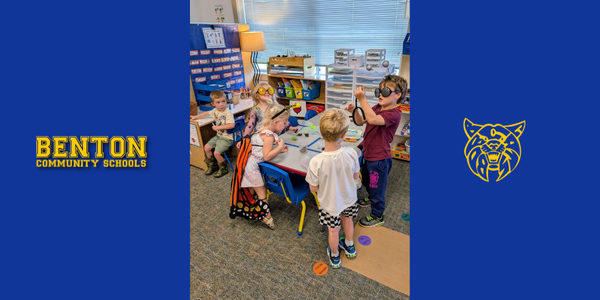Although it may seem deceiving, what looks like kids “just playing” in this photo is actually a prime example of our philosophy in early childhood education: self-selected exploration using intentionally designed environments, academic connections woven throughout the experience, freedom to move, purposeful communication, peer modeling, open-ended materials, and the teacher as the “guide on the side”. Let’s break down this photo with a little context:
1. The butterfly effect: See that little cup on the table? This is a female Monarch butterfly found outside the school entrance. It was not in the plans to include this during Center Time, but when opportunity comes knocking, we answer! Into the cup she went and an announcement was made that a special center activity would take place.
2. Setting the stage: Costumes, finger puppets, books about butterflies and other insects, and writing materials quickly were added. After reviewing expectations for safety, respect, and turn-taking, I stood back and watched the magic unfold. As I watched and supported, how children interacted with the materials evolved.
3. Following their lead: As their “guide on the side”, I was also an active participant, playing right alongside them, modeling skills like self-talk, communication, problem-solving, holding writing implements, cutting with scissors, and listening to others’ ideas and restating it to the group. Soon we were reading about which colors to use to attract butterflies and began drawing flowers, cutting them out, and creating our own “pollinator garden” in the classroom. I gave them milk straws and said, “This is your proboscis. Butterflies use this to drink something called nectar!” We then flitted around our pollinator garden drinking nectar.
4. Let creativity inspire you!: Authentic experiences prompt imagination. It just so happened that some of our butterfly wings were dropping glitter on the floor. “Look!”, I said. “There’s something called pollen! It came from the flower and now it’s on my leg, just like on a butterfly or bee! Look! It fell off on a different flower. That’s what happens when real butterflies and bees drink nectar, too! That’s how we get seeds and more flowers!” They all giggled and began rolling in the “pollen”.
Some of the best learning comes from inspired moments such as these.

